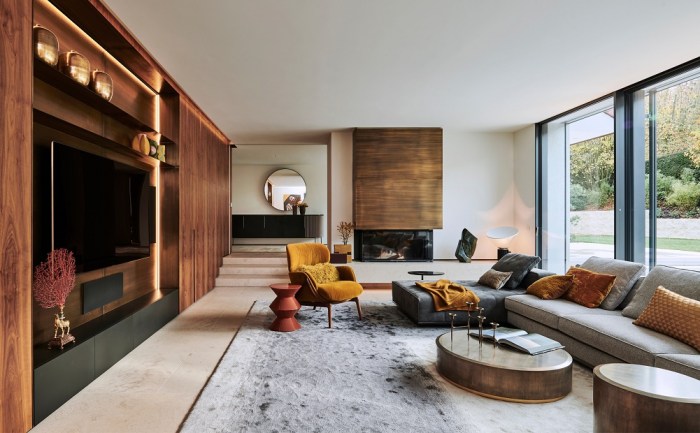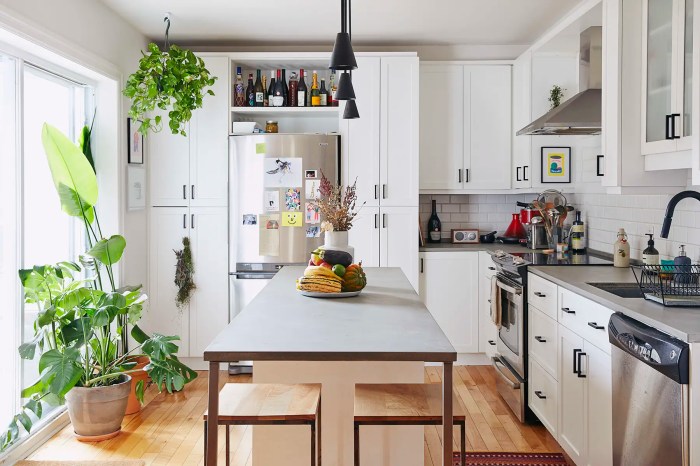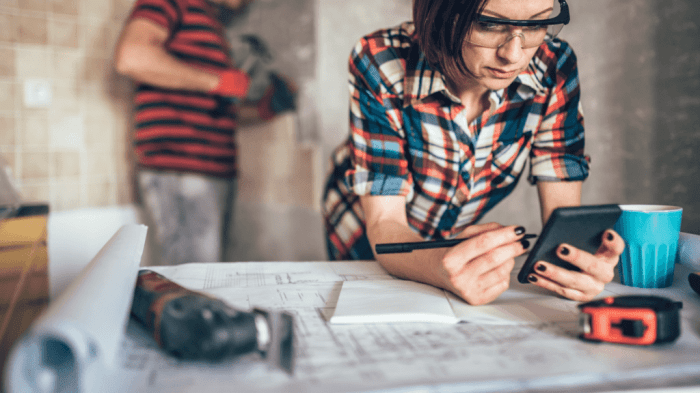
In the ever-evolving landscape of home design, 2024 promises a captivating blend of style, functionality, and sustainability. From embracing eco-friendly materials to integrating cutting-edge smart home technology, homeowners are seeking to create spaces that are not only aesthetically pleasing but also reflect a conscious approach to living.
This year’s trends are driven by a desire for personalized comfort, seamless connectivity, and a deep connection to nature. Whether you’re looking to enhance your existing home or embark on a complete renovation, these trends offer a roadmap to transform your living spaces into modern sanctuaries.
Sustainable and Eco-Friendly Design

Sustainability is no longer a trend but a necessity in home improvement. As we become more aware of our impact on the environment, homeowners are increasingly seeking ways to make their homes more eco-friendly. This shift towards sustainability is driving innovative design solutions that prioritize responsible resource use and minimize environmental footprint.
Eco-Friendly Materials and Practices
The use of eco-friendly materials and practices is crucial for creating sustainable homes. These choices not only reduce environmental impact but also contribute to healthier living spaces.
- Recycled and Reclaimed Materials: Using recycled materials, such as reclaimed wood, salvaged bricks, and repurposed furniture, reduces waste and minimizes the need for new resources. Reclaimed wood, for instance, offers unique character and adds a touch of rustic charm to interiors.
- Sustainable Flooring: Bamboo flooring is a rapidly renewable resource that is durable and aesthetically pleasing. Cork flooring, derived from the bark of cork oak trees, is naturally sound-absorbing and provides excellent insulation.
- Energy-Efficient Appliances: Investing in appliances with high Energy Star ratings significantly reduces energy consumption and lowers utility bills. Modern appliances often feature advanced technologies like smart sensors and variable speed motors to optimize performance and minimize energy waste.
- Low-VOC Paints: Traditional paints can release harmful volatile organic compounds (VOCs) into the air, impacting indoor air quality. Choosing low-VOC or zero-VOC paints minimizes these emissions, creating a healthier environment for occupants.
Design Trends for Minimizing Environmental Impact
Modern interior design is embracing trends that minimize environmental impact, creating stylish and sustainable homes.
- Biophilic Design: This approach incorporates elements of nature into the home, fostering a connection with the outdoors. Biophilic design often includes natural materials, plants, and natural light, promoting well-being and reducing stress.
- Minimalist Design: Minimalist design emphasizes simplicity and functionality, reducing clutter and maximizing space. This approach minimizes the need for excessive furniture and accessories, promoting a sense of calm and reducing material consumption.
- Sustainable Lighting: LED lighting is energy-efficient and lasts longer than traditional incandescent bulbs, significantly reducing energy consumption. Smart lighting systems can be programmed to adjust brightness and timing based on occupancy, further optimizing energy usage.
- Water Conservation: Low-flow showerheads and faucets reduce water usage without compromising comfort. Rainwater harvesting systems can collect and store rainwater for use in gardens or for flushing toilets, further minimizing water consumption.
Smart Home Technology Integration
Smart home technology is revolutionizing modern interiors, seamlessly blending convenience and functionality. By connecting various devices and systems within a home, homeowners can enjoy enhanced control, automation, and personalized experiences.
Examples of Smart Home Devices
Smart home devices are designed to automate and control various aspects of a home, making everyday tasks easier and more efficient. Here are some examples:
- Smart Lighting: Smart bulbs and switches allow homeowners to control lighting remotely, adjust brightness levels, and even set schedules for automatic on/off times. For instance, Philips Hue smart bulbs can be controlled via a smartphone app, enabling users to create different lighting scenes for various moods and activities.
- Smart Thermostats: These devices learn a homeowner’s temperature preferences and automatically adjust the heating and cooling systems to maintain optimal comfort levels. Nest Learning Thermostat, for example, analyzes user behavior and adapts to their preferences, potentially leading to energy savings.
- Smart Security Systems: Homeowners can enhance security with smart door locks, security cameras, and motion sensors. Ring Video Doorbell, for instance, allows homeowners to see who is at their door, even when they are away, and receive notifications in case of suspicious activity.
- Smart Entertainment Systems: Smart TVs, streaming devices, and home theater systems can be integrated to create a seamless entertainment experience. Amazon Fire TV Stick, for example, allows users to access a vast library of movies, shows, and music with voice control.
Benefits of Smart Home Technology Integration
Integrating smart home technology offers numerous benefits for homeowners, including:
- Increased Energy Efficiency: Smart thermostats, lighting systems, and appliances can be programmed to optimize energy consumption, potentially reducing energy bills. For example, smart thermostats can automatically adjust the temperature based on occupancy and weather conditions, minimizing unnecessary heating or cooling.
- Remote Access and Control: Smart home technology allows homeowners to control and monitor their homes remotely via smartphone apps. This provides convenience and peace of mind, enabling them to adjust lighting, lock doors, and check security cameras from anywhere with an internet connection.
- Enhanced Safety and Security: Smart home security systems can provide greater peace of mind by detecting potential threats and alerting homeowners. Motion sensors, door and window sensors, and security cameras can monitor a home and send notifications in case of suspicious activity.
Minimalism and Open Floor Plans

Minimalism is a design philosophy that emphasizes simplicity, functionality, and clean lines. It’s become increasingly popular in modern interiors because it creates a sense of calm and order. Open floor plans are another popular trend in modern homes, and they complement minimalist design perfectly.
The Appeal of Minimalism
Minimalism is all about creating a space that is both visually appealing and functional. This is achieved by removing unnecessary clutter and focusing on essential pieces. It prioritizes clean lines, neutral colors, and natural materials. The goal is to create a space that is both visually calming and functional.
Benefits of Open Floor Plans
Open floor plans have become a staple in modern home design. They create a sense of spaciousness and flow by removing walls and creating a more open and connected living environment. Open floor plans can also make a home feel larger, especially in smaller spaces. They are also well-suited for modern lifestyles that prioritize social interaction and entertaining.
Design Tips for Achieving a Minimalist Aesthetic
Here are some design tips for achieving a minimalist aesthetic in your home:
- Use Neutral Colors: Neutral colors create a sense of calm and serenity. Consider using shades of white, gray, beige, and black as your primary colors. You can then add pops of color with accessories.
- Incorporate Natural Light: Natural light is essential for creating a bright and airy space. Use large windows to maximize natural light, and consider using light-colored curtains or blinds to let in as much light as possible.
- Minimize Clutter: Clutter can make a space feel cramped and chaotic. Get rid of anything you don’t need or use, and find creative ways to store the things you do need. Consider using storage solutions like shelves, baskets, and drawers.
- Choose Simple Furniture: Minimalist furniture is characterized by clean lines and simple shapes. Look for furniture made from natural materials like wood, leather, or metal. Avoid furniture with excessive ornamentation or details.
- Focus on Functionality: Every piece of furniture should serve a purpose. Choose furniture that is both stylish and functional. For example, a coffee table can also serve as a storage space.
Biophilic Design and Indoor Greenery
Biophilic design is a concept that focuses on incorporating elements of nature into built environments. This approach recognizes the innate human connection to the natural world and aims to create spaces that promote well-being, enhance productivity, and foster a sense of connection to the outdoors.
Benefits of Indoor Greenery
Indoor greenery offers numerous benefits for modern interiors, promoting a healthier and more enjoyable living experience.
- Improved Air Quality: Plants naturally purify the air by absorbing pollutants like carbon dioxide, formaldehyde, and benzene. This can lead to improved indoor air quality, reducing the risk of respiratory problems and promoting overall health.
- Reduced Stress and Anxiety: Studies have shown that being around plants can reduce stress levels, lower blood pressure, and promote feelings of relaxation. The presence of greenery can create a calming atmosphere, helping to reduce anxiety and improve mental well-being.
- Increased Productivity and Focus: Incorporating plants into the workplace or home office can enhance productivity and focus. The natural elements can create a more stimulating and inspiring environment, reducing mental fatigue and promoting creativity.
Integrating Nature into Home Design
Homeowners can effectively integrate biophilic design principles and indoor greenery into their living spaces through various creative approaches.
- Living Walls and Vertical Gardens: These innovative solutions maximize space utilization and bring a vibrant touch to modern interiors. Living walls are vertical structures covered with plants, while vertical gardens are typically self-contained units that can be placed on walls or floors.
- Natural Materials: Incorporating natural materials like wood, stone, bamboo, and cork into furniture, flooring, and wall finishes creates a warm and inviting ambiance. These materials connect residents to nature’s textures and patterns, fostering a sense of grounding and tranquility.
- Organic Textures: Organic textures, such as woven fabrics, natural fibers, and rough-hewn surfaces, can bring a touch of nature indoors. These textures can be incorporated through furniture upholstery, rugs, curtains, and decorative elements, adding depth and visual interest to the space.
- Water Features: Small water features like fountains, tabletop waterfalls, or even a simple bowl of water with floating plants can create a calming and serene atmosphere. The gentle sound of flowing water can have a relaxing effect, promoting a sense of peace and tranquility.
Multifunctional Spaces and Flexible Design
The modern home is evolving to embrace flexibility and functionality, with multi-purpose spaces becoming increasingly popular. This trend reflects a desire for homes that adapt to changing needs and lifestyles, maximizing space and efficiency.
Creating Flexible Spaces
Homeowners can create flexible spaces through clever design choices and the use of multi-functional furniture. For example, a living room can be transformed into a guest room with the addition of a sofa bed, or a home office can be incorporated into a dining room by using a desk that folds away when not in use. Movable partitions can also be used to divide spaces as needed, creating adaptable areas for work, relaxation, or entertaining.
Maximizing Space and Functionality in Smaller Homes
In smaller homes or apartments, maximizing space is paramount. Multi-functional furniture is essential, such as a sofa bed that serves as both seating and sleeping space, or a coffee table with built-in storage. Vertical storage solutions, like shelves and wall-mounted organizers, can also help to maximize space and keep belongings organized. Open floor plans create a sense of spaciousness and allow for easy movement between different areas.
Home Improvement Straw – A Sustainable Approach
In the realm of sustainable building practices, a novel approach has emerged, utilizing straw bales as a construction material. This innovative method, known as “straw bale construction,” offers a compelling alternative to conventional building materials, promoting eco-consciousness and environmental responsibility.
Straw Bale Construction: A Sustainable Choice
Straw bale construction leverages the inherent properties of straw, a readily available agricultural byproduct, to create durable and energy-efficient homes. Straw bales, when properly processed and compacted, exhibit exceptional insulating capabilities, effectively reducing energy consumption for heating and cooling. This inherent insulation, coupled with the natural fire resistance of straw, contributes to a sustainable and comfortable living environment.
Benefits of Straw Bale Construction
- Exceptional Insulation: Straw bales possess remarkable thermal insulating properties, acting as a natural barrier against heat loss in winter and heat gain in summer. This inherent insulation contributes to energy efficiency, reducing reliance on heating and cooling systems and lowering energy bills.
- Natural Fire Resistance: Straw bales, when properly prepared and installed, exhibit inherent fire resistance. The dense packing and high moisture content of the bales hinder the spread of flames, providing a safe and secure living environment.
- Low Environmental Impact: Straw bale construction aligns with sustainable building principles by minimizing environmental impact. Straw is a renewable resource, readily available as a byproduct of agriculture. Its use reduces reliance on energy-intensive and polluting materials like concrete and steel, contributing to a greener footprint.
Incorporating Straw Bales into Home Construction
Straw bales can be incorporated into various aspects of home construction, offering versatility and aesthetic appeal.
Walls
Straw bales are commonly used for building walls, providing a natural and robust structure. The bales are stacked and secured with a mortar or a combination of earth and lime, creating a durable and insulated wall system.
Ceilings
Straw bales can also be used for constructing ceilings, offering excellent insulation and acoustic properties. The bales are typically laid on a timber frame and covered with a plaster or drywall finish, creating a smooth and aesthetically pleasing ceiling surface.
Furniture
Beyond structural applications, straw bales can be used to create unique and sustainable furniture pieces. Straw bale furniture, when properly treated and upholstered, offers a comfortable and eco-friendly seating option.
As we move forward, the future of home improvement lies in the harmonious fusion of innovation, sustainability, and personal expression. By embracing these trends, homeowners can create spaces that are both stylish and functional, reflecting their unique values and aspirations.
Key Questions Answered
What are some specific examples of eco-friendly materials for home improvement?
Some popular eco-friendly materials include bamboo flooring, recycled glass countertops, reclaimed wood, and low-VOC paints.
How can I incorporate biophilic design into my home without having a green thumb?
You can bring nature indoors with elements like natural stone accents, wood furniture, large windows for natural light, and even artificial plants if you prefer low-maintenance options.
What are some budget-friendly ways to achieve a minimalist aesthetic?
Start by decluttering and organizing your belongings. You can also use neutral colors, incorporate natural light, and choose furniture with clean lines and simple designs.




